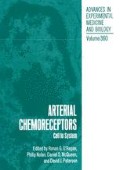Abstract
It has been suggested (Bernon et al., 1983; Biscoe et al., 1989; Roumy & Leitner, 1977) that cytosolic calcium concentration ([Ca2+]i) in type I cells controls the rate of release of a sensory transmitter and thus spike frequency in chemoafferent units. As the neurotransmitter has not yet been identified the question of its excitatory or inhibitory nature remains unsettled. Nevertheless, there must exist a unique relationship between changes in type I cells [Ca2+]i and variations of chemoafferent activity during stimulation if cytosolic calcium is to play such a critical role. I therefore measured [Ca2+]i of isolated type I cell clusters during hypoxia (PO2 down to 10 torr). However, as carotid body cells consume oxygen, there is, in vivo, a gradient of PO2 between blood an tissue, which magnitude is still a subject of debate, that might significantly differ from that between medium and isolated cells. Consequently, I also used cyanide which behaves as an inert gas at physiological pH, and thus equilibrates between blood and carotid body tissue or medium and cell clusters within a few tenths of a second with no concentration gradient (Forster, 1968). It should be remembered that cyanide already excites the chemoafferent units at 10µM concentration (Krilov & Anichkov, 1968 ; Leitner & Roumy, unpublished results). Finally the effects of changes in intracellular pH (pHi) thought to be involved in the chemoafferent response to CO2, were also studied.
Access this chapter
Tax calculation will be finalised at checkout
Purchases are for personal use only
References
Bemon, R., Leitner, L.M., Roumy, M., Vema, A. (1983). Effects of ion-containting liposomes upon the chemoafferent activity of the rabbit carotid body superfused in vitro. Neurosci. Lett. 35 : 289–295.
Biscoe, T.J., Duchen M.R., Eisner, D.A., O’Neill, S.C., Valdeolmillos, M. (1989). Measurement of intracellular Ca2+ in dissociated type I cells of the rabbit carotid body. J. Physiol. (Lond.) 416 : 421–434.
Buckler, K.J., Vaughan-Jones, R.D., Peers, C., Nye, P.G.C. (1991). Intracellular pH and its regulation in isolated type I carotid body cells of the neonatal rat. J. Physiol. (Lond.) 436: 107–129.
Forster, RE. (1968). The diffiision of gases in the carotid body. In “Arterial chemoreceptors.” R.W. Torrance, ed.. Blackwell, London.
Krylov, S.S. &Anichkov, S.V. (1968). The effects of metabolic inhibition on carotid chemoreceptors. In “Arterial chemoreceptors.” R.W. Torrance, ed.. Blackwell, London.
Roumy, M. &Leitner, L.M., (1977). Role of calcium ions in the mechanism of arterial chemoreceptor excitation. In “Chemoreception in the carotid body.” H. Acker et al, ed.., Springer, Berlin.
Rumsey, W.L., Iturriaga, R., Spergel, D., Lahiri, S., Wilson, D.F. (1991). Intracellular pH and chemoreception in the isolated perfused and superfused cat carotid body. In “Neurobiology and Cell Physiology of Chemoreception,” P.G. Data, S. Lahiri &H. Acker, eds., Plenum Press, New York.
Verna A., Talib, N., Roumy, M., Pradet, A. (1990). Effects of metabolic inhibitors and hypoxia on the ATP, ADP and AMP content of the rabbit carotid body in vitro : the metabolic hypothesis in question. Neurosci. Lett. 116 : 156–161.
Author information
Authors and Affiliations
Editor information
Editors and Affiliations
Rights and permissions
Copyright information
© 1994 Springer Science+Business Media New York
About this chapter
Cite this chapter
Roumy, M. (1994). Cytosolic Calcium in Isolated Type I Cells of the Adult Rabbit Carotid Body: Effects of Hypoxia, Cyanide and Changes in Intracellular pH. In: O’Regan, R.G., Nolan, P., McQueen, D.S., Paterson, D.J. (eds) Arterial Chemoreceptors. Advances in Experimental Medicine and Biology, vol 360. Springer, Boston, MA. https://doi.org/10.1007/978-1-4615-2572-1_22
Download citation
DOI: https://doi.org/10.1007/978-1-4615-2572-1_22
Publisher Name: Springer, Boston, MA
Print ISBN: 978-1-4613-6099-5
Online ISBN: 978-1-4615-2572-1
eBook Packages: Springer Book Archive

